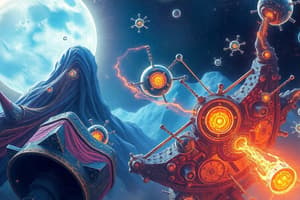Podcast
Questions and Answers
What layer of the Earth do the plates consist of?
What layer of the Earth do the plates consist of?
- Mesosphere
- Exosphere
- Troposphere
- Asthenosphere (correct)
Which layer of the Earth do the plates sit on top of?
Which layer of the Earth do the plates sit on top of?
- Mantle (correct)
- Crust
- Inner core
- Outer core
What is the real-life example given for a divergent plate boundary?
What is the real-life example given for a divergent plate boundary?
- Andes Mountains
- Himalayas
- Mid-Atlantic Ridge (correct)
- Rocky Mountains
In plate tectonics, what is the focus of an earthquake?
In plate tectonics, what is the focus of an earthquake?
Where is the epicenter of an earthquake located?
Where is the epicenter of an earthquake located?
What can P-waves travel through?
What can P-waves travel through?
Which wave is the second to reach a recording station during an earthquake?
Which wave is the second to reach a recording station during an earthquake?
What happens to P-waves and S-waves as they move further from the earthquake's epicenter?
What happens to P-waves and S-waves as they move further from the earthquake's epicenter?
Flashcards are hidden until you start studying
Study Notes
Plate Boundaries and Geological Processes
- Convergent Boundaries: Regions where tectonic plates come together.
- Subduction: Occurs when an oceanic plate collides with a continental plate and slides beneath it.
- Divergent Boundaries: Areas where tectonic plates split apart.
- Transform Boundaries: Locations where plates slide past each other.
- Seafloor Spreading: As distance from an earthquake's epicenter increases, the time gap between P-waves and S-waves also increases.
Atomic Structure
- Atoms: Basic particles of chemical elements.
- Subatomic Particles:
- Protons: Positive charge, located in the nucleus.
- Neutrons: Neutral charge, located in the nucleus.
- Electrons: Negative charge, found outside the nucleus.
- Mass Number: Total number of protons and neutrons in an atomic nucleus.
- Atomic Number: Number of protons in an element's nucleus.
Properties of Elements
- Metals: Hard, metallic-looking solids with high electrical and thermal conductivity, high melting, and boiling points.
- Nonmetals: Softer elements that may be colorful and exist as solids, liquids, or gases.
Minerals and Identification
- Silicate: Material containing silicon and oxygen.
- Mineral Identification Methods:
- Color
- Streak
- Luster
- Cleavage/Fracture
- Hardness
- Crystal shape
- Density
Rock Cycle
- Felsic Lava: High silica content, thick and slow-moving, produces light-colored rocks.
- Mafic Lava: Low silica content, hotter and more fluid, results in dark-colored rocks.
- Intrusive Igneous Rock: Forms beneath the Earth's surface, cools slowly, leading to larger crystals.
- Extrusive Igneous Rock: Forms above the Earth's surface from cooled lava, cools quickly, resulting in small to no crystals.
Weathering and Erosion
- Weathering: Process of breaking down rocks into smaller fragments without moving them.
- Erosion: Movement of sediment caused by wind, water, or gravity.
Lithification
- Lithification: Compaction of different sediments to form sedimentary rocks.
Types of Sedimentary Rock
- Chemical Sedimentary Rock: Forms when water evaporates from a mineral solution.
- Organic Sedimentary Rock: Composed of once-living organisms.
- Clastic Sedimentary Rock: Made from rock fragments.
Metamorphism
- Contact Metamorphism: Occurs over small areas where magma interacts with existing rocks.
- Regional Metamorphism: Takes place over large areas under extreme heat and pressure, often related to tectonic movements.
Earth's Major Plates
- Tectonic Plates: Earth’s crust contains 12 major tectonic plates.
Studying That Suits You
Use AI to generate personalized quizzes and flashcards to suit your learning preferences.




